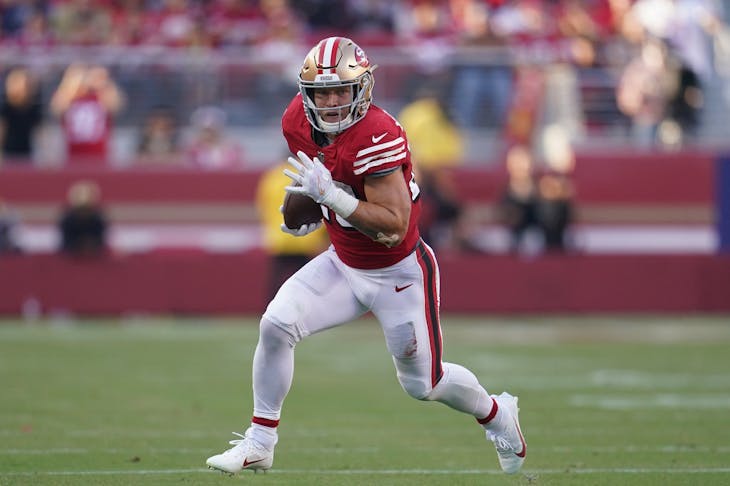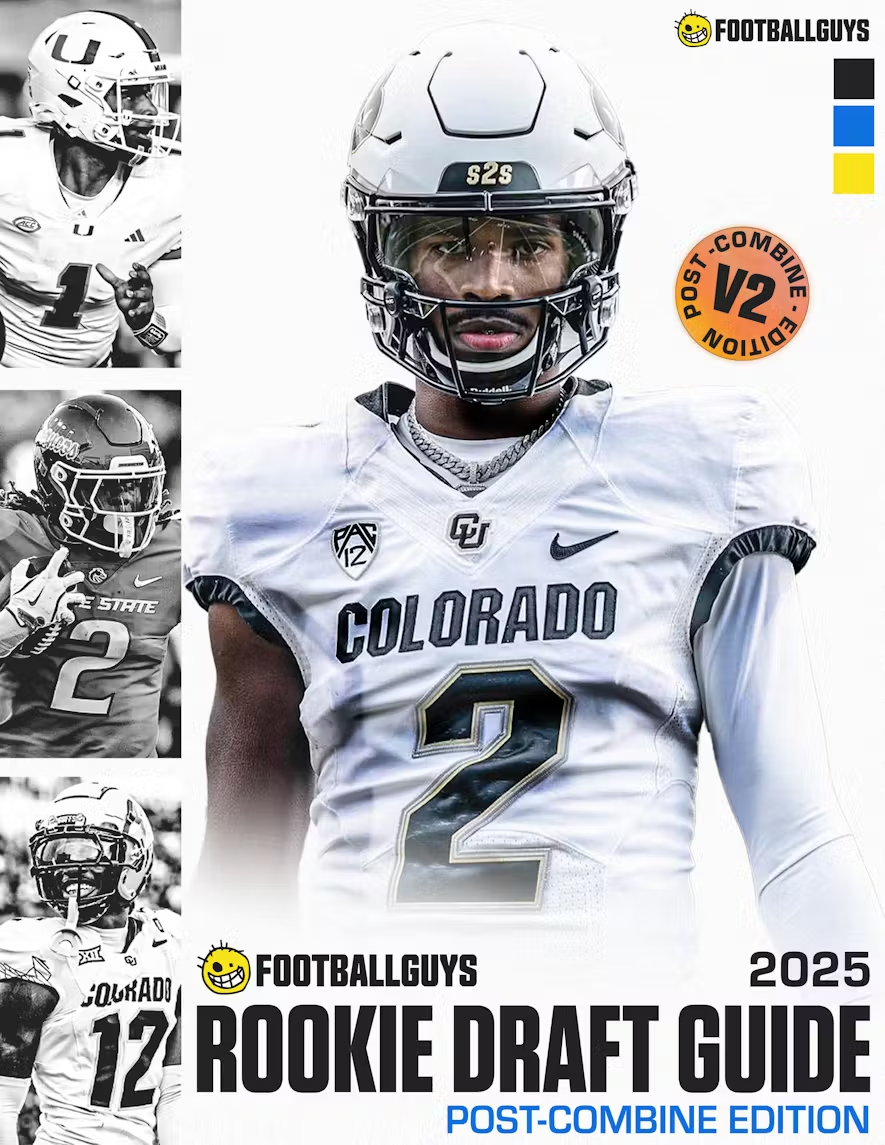
Each NFL team is its own fantasy football organism. Will they thrive or die in 2018? This series outlines the critical questions for each team across their skill position depth charts. In this edition: NFC South
Who is the No. 2 wide receiver in Atlanta?
Calvin Ridley was drafted in the first round by the Falcons. The incumbent veteran for the role is Mohamed Sanu.
Verdict: Both are outside the Top 50 in positional ADP due to Julio Jones as a dominant WR1 on the offensive target pecking order. However, Sanu finished in the top-40 of PPR PPG in 2017 on nearly 100 targets. The 'next big thing' chasers annually disregard steady veterans, assuming an early and pronounced step forward for young options. This year's Falcons depth chart is a good example. Ridley, while a big recruit from an elite program, underwhelmed in college and finished with a tepid prospect profile considering he is on the old side, lacking strong physical traits for his lagging size, and did not dominate production-wise (by market share or raw numbers). On the flip side, Sanu has averaged 10-12 PPR PPG over his seasons in Atlanta will be a hindrance, if not stifling, Ridley's upside all 2018. If seeking bye week or injury depth in the WR3/4 zone, target Mohamed Sanu. Any game Julio Jones is out, Sanu will be on the WR2 radar.
Will Austin Hooper be a top-12 tight end?
Austin Hooper was a Day 2 selection by Atlanta in 2016, progressing in his second season to more than 7 PPR PPG and 500+ receiving yards as an ancillary target in the Falcons offense.
Verdict: While the tight end position is wide open beyond the top few options for emerging TE1 performers, volume is paramount. Hooper collected 65 looks last season and his middling TE2-level finish mirrored his usage. Hooper's best plays have been as a benefactor of getting lost by opposing secondaries for coverage busts and wide open space downfield. Surpassing 90 targets or seeing a signficant touchdown rate boost will be key to rising into the top-12. The addition of Calvin Ridley as a WR3 of note this season reduces Hooper's chances to see the target spike he needs. Hooper's best chance (althought minimal) this season is to see a red zone usage increase from only nine targets a year ago, well behind Julio Jones and Mohamed Sanu of the receivers on the team.
Does Christian McCaffrey develop into a high-volume running back?
Christian McCaffrey was the No. 7 overall pick in the 2017 draft after an elite run of production at Stanford. While undersized, McCaffrey saw a whopping 113 targets (80 receptions) in the passing game en route to a successful fantasy performance in 2017.
Verdict: McCaffrey garnered the 'gained weight' news blurb this offseason, which is typically troubling for a smaller back, especially so as McCaffrey's biggest film knock as a rookie was his inability to make plays beyond the first defender (whether breaking a tackle or eluding a tackle attempt). With McCaffrey's agility, explosion, and speed already a question heading into 2018, extra weight adds to the concern. While Jonathan Stewart is gone in free agency in the power back role, C.J. Anderson was added to fill the void, freshly off a 1,200-total-yard season in Denver, his best NFL stat line to-date. Anderson, when healthy, is poised to be an upgrade over Stewart at their respective stages of career arc. Cam Newton's goal line acumen and Anderson's addition make McCaffrey unlikely to challenge the other quality fantasy options in terms of rushing upside. Fantasy-wise, McCaffrey does not need to be a high-volume runner to produce (top-15 in PPR PPG last season with only 117 rushes and two scores on the ground) due to his elite receiving volume. However, in the big picture, the volume will dry up if the efficiency continues to wane on a per-touch basis.
Who is the passing game piece to own in Carolina?
Excluding Christian McCaffrey, who led the team in targets last season, the leading candidates in the passing game include Devin Funchess, D.J. Moore, Torrey Smith, and Greg Olsen.
Verdict: In 2014-16 Greg Olsen saw 120 or more targets each season. 2017 was derailed by an early-season injury, but Olsen did rebound to see 27 targets over the final three weeks once back in the fold. In his place Devin Funchess had his career-best season to-date, amassing 112 targets and finishing in the top-30 fantasy receivers in PPR PPG. Torrey Smith is adequate depth for an NFL depth chart but is years removed from his impactful level in Baltimore as one ofthe better deep threats in the NFL. D.J. Moore is an incoming rookie with a thick build and quality metric profile, matched by his Round 1 selection by Carolina. Compared to their respective cost, Greg Olsen is the play in 2018. While he explored after-the-NFL broadcasting during the offseason, Olsen is back to the field for at least one more year. Olsen has been at times the only fantasy producer in Cam Newton's passing game in recent seasons. At TE5/6 in July redraft ADP, Olsen has upside from there considering the competition for targets in Philadelphia (Zach Ertz) and New York (Evan Engram) with options ahead of Olsen in positional ADP.
Where does Mark Ingram fit in fantasy football draft plans?
Mark Ingram is suspended for the first four games of the season.
Verdict: The key things to remember for Mark Ingram are situation and timing. First, the Saints backfield has been one of the most fertile grounds for PPR fantasy production in the NFL during the Sean Payton and Drew Brees era. Both Ingram and Alvin Kamara were top-7 PPR PPG options in the same backfield, combining for 140 receptions. Alvin Kamara was optimized on his dual-threat touches last year but will be pressed into more usage early in the season with Ingram out. The second aspect of Ingram's suspension is timing. The first four games are the least important on the fantasy calendar. Where a running back makes his fantasy season is during the bye weeks and especially during the fantasy playoffs. Ingram will be done with the suspension by both sections of the season. Ingram's ADP offers a strong profit potential as his July ADP is in the RB25-30 range, amidst Jay Ajayi, Nick Chubb, Dion Lewis, and Tevin Coleman to name a few backs. Ingram can be comfortably drafted as a team's RB3 with no pressure during the opening month to be missed during his suspension. Then later in the critical weeks of the year, he will transition to being an impact starter.
Is Ronald Jones more overvalued or Peyton Barber more undervalued?
Ronald Jones' early July ADP is in the RB20-25 range. Peyton Barber sits around RB60. What is the play for the Tampa Bay backfield in 2018?
Verdict: Jones' profile is a concerning one entering the NFL. Jones is undersized to project as an NFL lead back and his receiving production is questionable for a back of his size. Jones did not log an official 40-time during the draft process due to pulling a hamstring partway through his first attempt at the NFL Combine but was not on pace to hit his 4.40 projection either way. Jones is projected by the Footballguys staff as slightly overrated by ADP, fitting more in the RB25-30 range. Jones is difficult to project with better pass catchers on the roster (namely Charles Sims) and a better goal line option (Peyton Barber) to take short touchdown opportunities away. Peyton Barber could be the Week 1 starter considering Jones' passing game acumen is a question and rookies typically take longer than fantasy owners expect to become featured in their respective offenses. Barber finished strong in 2017, finally with a solid stretch of opportunity as Tampa Bay's starter. Barber logged 15 or more touches in four-of-five games to close the season. Barber has also trimmed down this offseason, a perk of being prototypically-sized coming into the NFL as they can shed some weight and add explosiveness to their still-lead-back frame. Barber is poised to be an early-season value compared to his ADP with upside from there if Ronald Jones should falter at all in the opening month of the season.
Is a Year 2 breakout coming for O.J. Howard?
O.J. Howard flashed at times en route to his TE18 PPR PPG finish as a rookie. The Round 1 tight end had a strong six touchdowns on only 26 receptions.
Verdict: The biggest question with Howard is competition for targets. Tampa Bay (read: Jameis Winston) loves to feature the tight end down the middle of the field, but bringing back Cameron Brate (14 touchdowns over last two seasons, 159 targets) was a surprising free agent move for Tampa Bay considering their investment in O.J. Howard. Add in Mike Evans as a strong WR1 and DeSean Jackson and Chris Godwin as ancillary receivers and splitting the target pie for an O.J. Howard true breakout is tough for 2018. At least 80 targets (and preferably 90+) is what a tight end needs to traditionally get into the top-10 for fantasy, outside of rare touchdown rate production. For Howard, the roadblock of Cameron Brate on the same depth chart severely limited his chances to get to the target threshold in 2018. As a result, Howard will need to get there with touchdowns, specifically double-digit scores if Howard progresses, but does not get to the 80+ target zone. Howard fits in the upside TE2 bucket more than the logical breakout bet for top-10 production zone of tight end projections.
Ben Watson or Ted Ginn Jr, who is the better veteran depth option in New Orleans?
Ben Watson rejoins the Saints after a career year in 2015 with New Orleans his last time in town. Ted Ginn Jr is the de facto No.2 receiver with Cameron Meredith signed after a 2017 injury in Chicago and Tre'Quan Smith drafted on Day 2 this year.
Verdict: Ginn is the speed element of the offense, but his share of the target pie is not increasing from his 70 looks a year ago. There was minimal WR3 presence on the depth chart in 2017 with Willie Snead a non-factor and Brandon Coleman sees only 37 targets. Cameron Meredith and Tre'Quan Smith can do at least that well in 2018 if not significantly better. On the other hand, Ben Watson was signed to be the starter at tight end. While Watson has slowed over the past two seasons in Baltimore, the Saints have shown no signs to give Josh Hill more targets over the years and Michael Hoomanawanui is the classic NFL TE2/3. Watson is affordably going off the board outside the top-25 tight ends in early July ADP and is one of the select few in the range with weekly starter upside.

